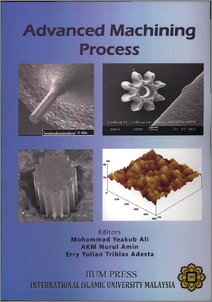Khan, Ahsan Ali and Mohd Ali , Munira and Mohd Shaffiar , Norhashimah
(2011)
Relationship between machining variables and process characteristics during wire EDM.
In:
Advanced Machining Processes.
International Islamic University Malaysia, Kuala Lumpur, Malaysia, pp. 28-32.
ISBN 9789674181628
![[img]](http://irep.iium.edu.my/style/images/fileicons/application_pdf.png)  Preview |
|
PDF ( Relationship between machining variables and process characteristics during wire EDM)
- Published Version
Download (536kB)
| Preview
|
Abstract
Abstract. Wire EDM is in use for a long time for cutting punches and dies, shaped pockets and other machine parts. Surface finish of the machined surface mainly depends on current and voltage used during machining. In the present work experimental investigations have been conducted to establish relationships job surface finish with current and voltage. Brass wires of diameters 0.3 mm, 0.25 mm, 0.20 mm and 0.15 mm were used. Work materials tested were mild steel, aluminium, cemented carbide, copper and stainless steel. After machining each material with specific current and voltage the hardness and the job surface roughness were measured and their surfaces were observed under a scanning- electron microscope. Results of the experiments show that in general the machined surface becomes rougher with increase in current and voltage. Microstructures of the specimens also show that craters on the finished surface become larger as a result of using higher current and voltage. It was also found that wires of smaller diameters give smoother surface than those cut with larger diameters. It has been established that machining of carbides should be limited to wires with diameter equal to or less than 0.15 mm. Use of wires of greater diameters causes frequent wire breakage.
Actions (login required)
 |
View Item |


 Download Statistics
Download Statistics Download Statistics
Download Statistics